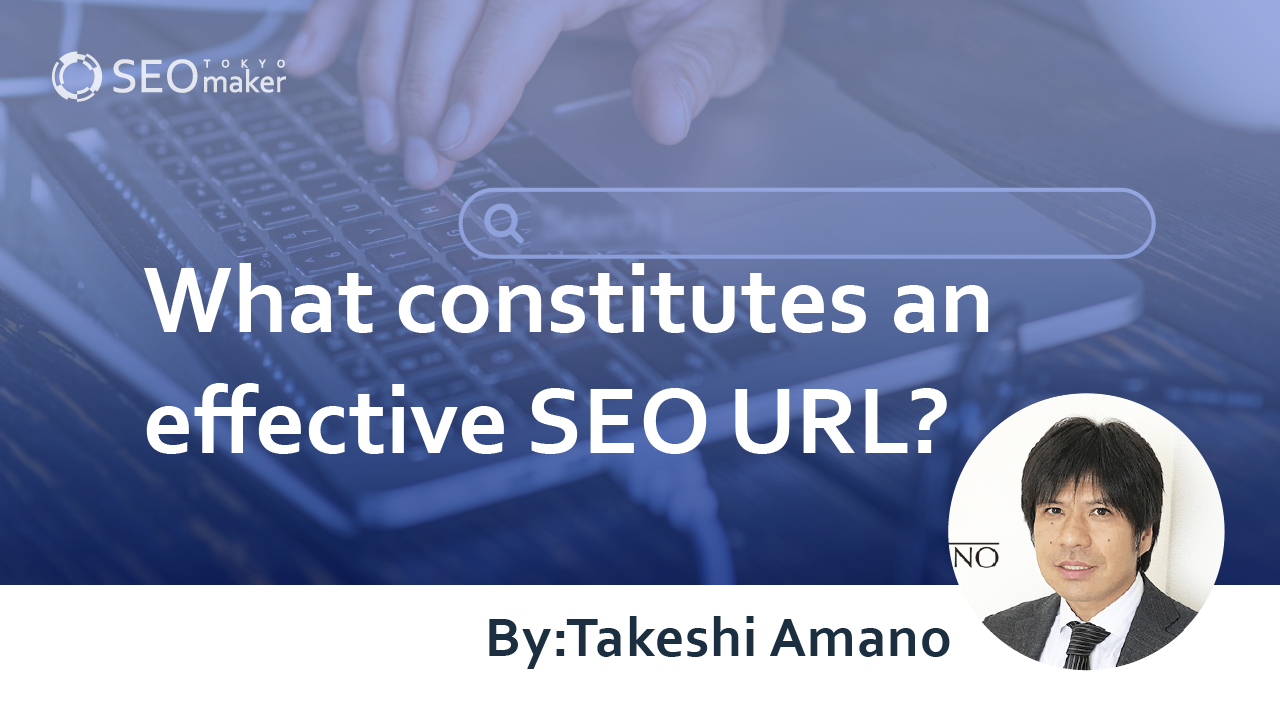What constitutes an effective SEO URL? : Explaining the Key Points
contents

When building or renovating a website, the structure of the URL can often be a major point of contention. It is clear that URLs influence search rankings, thus they must be designed properly.
To optimize a URL for SEO, attention should be paid to its length, the use of alphanumeric characters, and directory structure. It is also important to consider normalization and HTTPS implementation of URLs. Knowing what constitutes a disadvantageous URL can help prevent future issues.
Related Article: What is a URL? Explaining Its Meaning and Components Clearly
In this article, we will discuss both advantageous and disadvantageous URLs effective for SEO, their characteristics, and setup. Also, we’ve discussed Japanese URLs from an SEO perspective, so please refer to that for guidance.
The Relationship between SEO and URLs
Three key considerations for the relationship between SEO and URLs are:
- -Including Keywords in URLs
- -URL Length
- -SEO-Optimized URLs
Including Keywords in URLs
Including keywords that represent the content in URLs can enhance SEO effectiveness. When a URL clearly reflects its content, it becomes a user-friendly and commendable feature.
John Mueller of Google also commented on Twitter.
“The SEO effect of keywords in the URL is minimal once the content is indexed. Make URLs work for your users, not for SEO. Also, changing URLs on an existing site is a site-migration & it will take time/fluctuations to be reprocessed, so I would avoid that unless it is critical.
— 🥔 johnmu (personal) updated for 2022 🥔 (@JohnMu) August 19, 2020
Since URLs are displayed in search results, including keywords can make the content more understandable and clickable by users. Even if a URL has a complex structure, it is not an issue for search crawlers, but a keyword-inclusive URL is more trustworthy from a user-first perspective.
Using clear categories and file names in your website’s documents not only helps organize the site effectively but also makes it easier and more user-friendly for those linking to your content. Extremely long and cryptic URLs that include unintelligible words can confuse visitors.
Source: SEO Starter Guide (Search Engine Central)
URL Length
The length of a URL does not have a significant impact on SEO, but overly long URLs may be perceived as spam by users and tend to be visually unappealing and avoided.
Furthermore, when shared on social media, long URLs can dominate the character count or risk being truncated. To avoid such issues, URLs should be kept short and concise.
A concise URL also makes it easier for search crawlers to understand the page content, improving crawlability.
John Mueller from Google Search Central has explained this.
SEO-Conscious URLs
Designing user-friendly and search crawler-friendly URLs is the essence of SEO in URLs. This includes succinctly representing content and including keywords in the URL.
Such URL design can make pages more likely to appear in search results and increase the opportunities for users to view the pages.
Reference: Search Engine Optimization (SEO) Starter Guide | Organizing Your Site’s Hierarchy
Key Points of Effective SEO URLs
An effective SEO URL captures the following six key aspects.
- 1. Content-aligned URLs
- 2. Concise URLs
- 3. Use of alphanumeric and symbols
- 4. Static URLs
- 5. URLs with shallow directories
- 6. URLs with a shallow link hierarchy
When creating and launching new pages or sites, ensure the URL encompasses these points.
Aligning with Content
Include keywords in the URL that reflect the content of the page. This allows users searching the web to infer the content from the URL itself, enhancing convenience and establishing a trustworthy URL.
For example, if a content titled “Investment Methods Anyone Can Use” has a URL like “toushi-sagi” (investment scam), no matter how earnest the content, it won’t be trusted.
Also, avoid URLs crammed with keywords. These types of URLs tend to be lengthy and verbose. They are not only cumbersome but also disliked by both search crawlers and users due to the suspicion of spam.
A URL is essentially a content’s billboard. It is crucial to keep it simple and clearly indicate the information provided.
Concise URLs
URLs should be simple and as short as possible. Overly long URLs can appear cryptic and suspicious, making them difficult to share and potentially reducing user engagement. Such inconvenient URLs are unlikely to be effective for SEO.
However, depending on the content, it might be challenging to achieve a simple URL if the necessary information makes it longer.
For those using WordPress, one solution could be to use URLs based on post IDs. While this doesn’t convey the content of the posts, it keeps the URLs simple and short, which is beneficial for sharing on social media without overwhelming the character limit.
This indirectly enhances convenience, thus potentially improving SEO.
Reference: Maintaining a Simple URL Structure
Using Alphanumeric and Hyphens
It is advisable to use alphanumerics and symbols in URLs. The symbols that can be used are either hyphens (-) or underscores (_). Here is how to use each:
(Hyphen) – Use to separate multiple words.
_ (Underscore) – Use to connect multiple words.
For example, a URL for a page dealing with red kimonos would include ‘red’ and ‘kimono’ in the URL. Since these are two separate words, they would be connected as ‘red-kimono’ with a hyphen.
Using hyphens in URLs helps convey the content of the site to both users and crawlers clearly, when multiple words are involved.
When using underscores, such as in a URL for a page dealing with cheese hamburgers, the words ‘cheese’ and ‘hamburger’ would be included. Since these two words together represent one item, they would be connected as ‘cheese_hamburger’.
While Google recommends using hyphens over underscores in URLs, using underscores is not problematic. However, use hyphens unless there is a specific reason not to.
Shallow Directory URLs
When building your site, organize content by category into a clear directory structure. For example, a URL for a page displaying summer fruits under the fruit category might look like this.
https://example.com/fruit/summer
By avoiding unnecessary directories and keeping the structure shallow, users can easily understand where they are on the site and access the desired pages more efficiently. This can result in longer visit durations and higher site navigation rates.
If the directory hierarchy is too deep, it becomes cumbersome for users to reach their desired pages, and it also reduces the efficiency of crawlers navigating the site. Therefore, keep your directory hierarchy shallow, which also contributes to shorter URLs.
Recommended Article: How to Create a Strong SEO Directory Structure
Shallow Link Hierarchies in URLs
A link hierarchy refers to the number of clicks required to access a desired page. Google considers pages with fewer link layers as more important, and this affects their search rankings.
Therefore, pages aiming for high search rankings should be accessible within one or two clicks from the homepage.
It’s important to remember that directory depth is not the same as link depth.
For example, consider a deeply nested page in the directory structure.
https://example.com/category/category2/category3/page.html
Navigating directly to this URL could be cumbersome, but if there’s a direct link to this page from the homepage, the link hierarchy remains shallow.
Top pages that attract a lot of traffic are more easily recognized by crawlers, and an ideal site allows access to all pages with few clicks starting from these pages. Such sites achieve high crawlability.
This enables crawlers to recognize the content across the site more efficiently, making it more likely to appear in search results and achieve higher rankings.
Disadvantages in SEO URL Structures
Three types of SEO-unfriendly URL structures are;
- URLs containing unnecessary characters
- URLs with fluctuating structures
- Date and time stamps
These URLs are hard to distinguish, often avoided by users, and lead to reduced crawlability, which is why Google does not recommend them.
URLs containing unnecessary characters
Unnecessary characters include those crammed with keywords without clear purpose, or mixed use of uppercase and lowercase letters. URLs should be simplified: use lowercase letters consistently and limit keywords to those that are central to the content.
Additionally, Japanese URLs can sometimes not be correctly identified by browsers and may be displayed as symbols. Even if they appear correctly on a browser, copying and pasting the URL or sharing it on social media can convert it to a string of symbols, making it very hard to read.
More details on Japanese URLs will be discussed later.
Fluctuating URL Structures
For example, on e-commerce sites, users can search for products and sort the results by popularity or price. Even if the displayed results are the same, the URL changes whenever users rearrange the search results.
Google views multiple URLs for identical search results negatively, considering it as duplicate content. This can lead to penalties such as not being displayed in search results or a drop in rankings.
Date and Time
When publishing a page, sometimes URLs are set based on the date of creation or publication. This type of URL should be avoided because dates are inherently fluid and always advancing. Additionally, once a URL is set, it generally does not change.
Even if the content of the page is updated two years after publication, the URL remains the same as it was two years ago. This can lead to a mismatch between the URL and the content of the page, causing confusion for users.
URLs based solely on dates tend to become redundant and do not represent the content of the content. If there is a concise word that better represents the content, it should be used instead.
(h2)SEO Perspective on Japanese URLs
There are URLs that contain Japanese characters. Here are three considerations when using URLs with Japanese.
- -Impact on search rankings
- -Risk of character corruption
- -Limitation of target users
Unless there is a specific reason, it is safer to use English in URLs.
(h3)Impact on Search Rankings
To conclude, Japanese URLs do not directly impact SEO. However, including Japanese can increase visibility and make a site easier to access, indirectly improving usability.
It can also enhance click-through rates from Japanese users, earning their trust more readily.
Years ago, Japanese URLs had a significant effect due to the algorithm at that time. However, now there is little to no impact. It is advisable to avoid using Japanese URLs solely for attempting to gain an SEO advantage.
Risk of Character Corruption
When URLs contain Japanese characters, they may be converted into alphanumeric characters and symbols when displayed in browsers or on social media platforms. This can result in URLs becoming excessively long, and they are often automatically replaced with shortened URLs.
This means that Japanese URLs can be transformed into a combination of alphanumeric characters and symbols, and further into shortened URLs. When these URLs are linked from various systems or servers, there may be issues with how they are processed.
External links are an important part of SEO. Japanese URLs carry the risk of these links not functioning correctly.
Additionally, URLs that experience character corruption can cause skepticism among users who see them. This makes them less likely to be shared on social media and harder to gain trust.
Limiting Target Users
Japanese URLs are, of course, only understandable to users who know Japanese. If your site or service is targeted solely at users within Japan, this is not an issue.
However, if you are communicating to or planning to reach an international audience, it’s best to avoid Japanese URLs. Using Japanese URLs requires careful consideration of the target audience, the direction of the site, and future plans.
Essential Settings for Effective SEO URLs
There are two key settings to implement for SEO-effective URLs.
- -URL Normalization
- -Implementing https
Especially, https is crucial as it enhances the security of your site and should always be implemented.
URL Normalization
If two pages deal with the same content, they can be seen as duplicate content by search engines, which could negatively impact search rankings.
Google’s search crawlers evaluate pages based on their URLs. This means that even if the content is the same, different URLs will be recognized as separate pages.
Examples of different URLs include those with or without a slash or the presence of “index.html.” If applicable, URL normalization should be addressed promptly. This can be done using canonical tags or 301 redirects to ensure proper handling by search engines.
Implementing https
Implementing https on a site enhances the security of data transmission between the user’s device and the site they are browsing. It prevents unauthorized third parties from obtaining user information and should be adopted for any site.
Accessing a non-HTTPS site can result in browsers displaying warnings such as “not secure” in the URL bar or even blocking access. This undermines trust from users and can lead to a decrease in website traffic.
Google has officially announced that sites with https are favored in search rankings.
Over the past several months, Google has been testing the use of encrypted, secure connections as a signal in their search ranking algorithms. Given the positive outcomes of these tests, Google has decided to incorporate HTTPS as a ranking signal.
Source: HTTPS as a Ranking Signal (Google Search Central)
Implementing https is essential for creating an SEO-beneficial site.
Summary
An effective SEO URL is one that considers both users and search crawlers. This includes keeping URLs short and simple, using English and hyphens, and including keywords relevant to the page content in the URL. One way to shorten URLs is by minimizing the depth of directory and link hierarchies. Specifically, link hierarchies should be designed so that all pages are accessible within one or two clicks from the homepage to enhance SEO impact. Additionally, normalizing URLs and implementing https are crucial. The former helps avoid penalties associated with duplicate content, while the latter boosts site security and builds user trust.
Top of Form










![What is a Description? Explaining the Meaning, Writing Style, and Changing Word Count – [2023 Edition]](https://www.switchitmaker2.com/en/wp-content/uploads/2024/09/what-is-description.webp)










